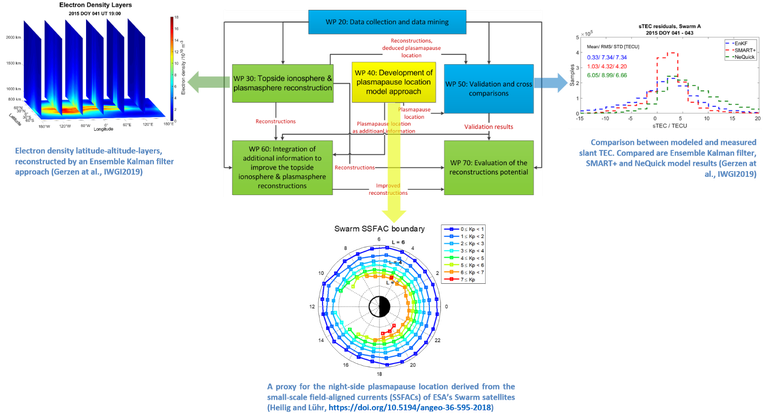Multi-Satellite ionosphere-plasmasphere Electron density reconstruction (MuSE)
The German Research Foundation (DFG) established the Special Priority Programme SPP 1788 Dynamic Earth focusing on the quantification of terrestrial transport mechanisms and solar-terrestrial interactions. As part of this SPP, the project MuSE aims at the improvement of our understanding of the structure and the dynamics of the ionosphere-plasmasphere system. The project will result in the deployment of a three-dimensional (3-D) assimilation procedure, e.g. based on Ensemble Kalman filtering, for the topside ionosphere and plasmasphere reconstruction, capable to use various measurements and exploiting especially the measurements of low-Earth-orbiting (LEO) satellites. A significant part will be the development of a plasmapause location model and its implementation into the reconstruction procedure. Using independent plasma density and whistler measurements, the results will be validated and cross checked. The potential of the new reconstruction approach will be evaluated by analysing space weather events, taking benefit of the results obtained in parallel projects within the SPP 1788.
The plasmasphere is an extension of the ionosphere, the ionized part of the Earth's upper atmos-phere. The ionization is mainly caused by the solar radiation in the EUV wavelength range and by energetic particles originating from the solar wind. Thus, the ionospheric and plasmaspheric state are closely related to the current level of solar activity and associated with space weather events such as solar flares and coronal mass ejections (CME). The atmosphere reacts to the highly variable solar energy input in a very complex manner including coupled processes in the magnetosphere, plasmasphere, ionosphere and thermosphere. To improve our understanding of even particular processes a comprehensive view on this coupled system is required.
In addition, there is a growing interest of the satellite user community to describe the temporal and spatial characteristics of the electron density in the ionosphere and plasmasphere. Trans-ionospheric radio signals, transmitted from satellites used in telecommunication, navigation or remote sensing, are affected by the electron density along their ray path by refraction, reflection, diffraction and scattering. Therefore, the knowledge of the state and the dynamics of the electron density are of great practical importance. So far, however, the electron density distribution within the ionosphere and plasmasphere is not well described.
As part of DGFI-TUM’s research activities in ionosphere modeling, MuSE is thematically closely connected to the projects TIK, INSIGHT-II and OPTIMAP.

Arcisstraße 21
80333 München